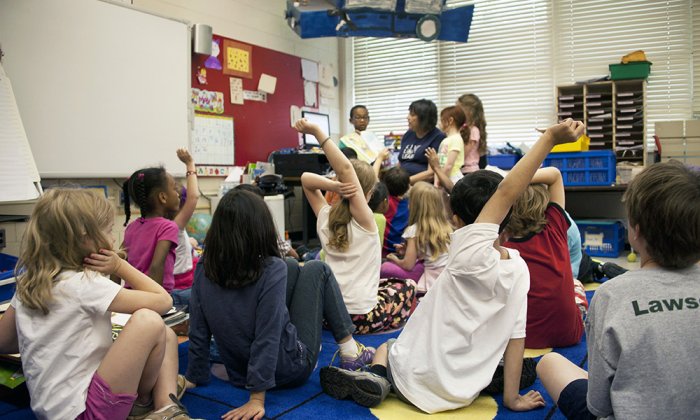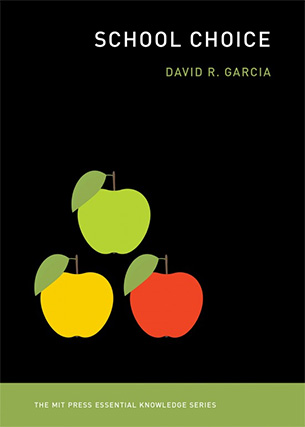School Choice: A User Guide

At first blush, school choice may appear noncontroversial, even a humdrum topic. Yet, writes education researcher, author, and one-time Arizona gubernatorial Democratic nominee David Garcia, it’s one of the most controversial public policy issues of our time, with extensive implications that influence educational and societal outcomes for all students.

The questions at the core of this contentious debate: Who has the authority to determine which schools students can attend? Should the decision be determined by elected officials acting on behalf of their community and administered through government-controlled school systems? Or should parents be allowed to make school choice decisions based on individual interests?
On the ground, many families just want to know what option is best for their children and what the impact of their choices will be on their communities. We asked Garcia to explain some of the key differences between types of schools — among them, traditional public schools, charter schools, and magnet schools — and why the history of school choice policies is so important.
The Editors: School choice was the last thing on my mind until I started researching options for my daughter, who’s entering kindergarten this year. Navigating the process has been more confusing than expected. Has it always been this way?
David Garcia: I’m not surprised that school choice was the last thing on your mind when your daughter started school because “choosing a school” is a relatively new concept. For over 200 years, the vast majority of American parents “chose schools” by moving to neighborhoods with the best schools (and other amenities) that they could afford, and their children attended the local neighborhood school. The exceptions being the small percentage of parents who either home schooled their children or sent them to private schools. The idea of attending public schools outside your local neighborhood without an associated residential move has only been part of the educational process since the proliferation of school choice policies some 30 years ago.
Editors: What are some of the school choices available now that weren’t an option half a century ago? And what are some of the key differences between them — specifically between traditional public schools and charter schools?
DG: The schooling landscape is rather complex these days. Depending on the state where you live, school choice policies allow parents to decide from a number of options including traditional neighborhood public schools, magnet schools administered by public school districts, public schools outside your neighborhood school district through open enrollment, charter schools, and public funding to attend private schools or receive private educational services through vouchers and empowerment scholarships.
With respect to teaching and learning, there are no major differences between traditional public schools and charter schools, overall. Both types of schools follow state academic standards and standardized testing requirements. Parents may find, however, that charter schools are generally smaller and are more likely to be based on a specific academic focus (e.g., arts, back to basics, credit recovery). Private schools are not governed by state academic requirements and, as such, establish their own curricula and testing requirements.
There is no long-term, sustained, empirical evidence that one type of school is superior to the others overall.
Parents should be aware of a few key differences among school types. First, if students are attending school outside their residential school district, it is very likely that parents must provide transportation to and from school. Very few charter or private schools provide transportation and many school districts do not provide transportation for students attending from outside the district boundaries via open enrollment. Second, parents should expect to encounter more out-of-pocket fees (e.g., private school tuition, activity fees, family contributions) in charter and private schools. Third, due to economies of scale, traditional public schools generally offer more robust special education services because they can educate many students at once. Charter schools, largely due to size, are more constrained in the special education services they provide.
Editors: Can you outline some of the arguments for and against these options?
DG: For parents, there are no global arguments for or against any particular type of school. The objective of the school selection process is to find the best match for your child and family. What I tell parents is that there is no “best” school. Rather, there is the “best” school for their child. For example, if parents pay attention to school ratings and identify one of the top “A”-rated schools (school ratings are often based primarily on standardized test scores), the “top” school may not be the best option for their child because their interests are better aligned with other schools. For example, their child may have a proclivity for science, preferring to attend a science-based charter school. Or, they may be interested in the full spectrum of sports and clubs that a comprehensive traditional public high school is more likely to provide.
Editors: What are the implications of school choice for communities at large? Is there research on how, for example, charter or magnet schools affect their economic development?
DG: School choice complicates the relationship between quality schools and higher property values because the policies sever the traditional connections between homes and schools. Historically, families had to locate in communities where they essentially had exclusive access to quality schools, which, in turn, raised the property values in those communities. Under school choice, however, families are not forced to move residences to take advantage of quality school choice options outside their local communities. Families can live in one community while their student attends a school in another community. Similarly, charter schools can locate near, but not necessarily within, a particular community to attract students from that community.
Editors: What would be the reasoning or incentive for a charter school to do that? When this happens — that is, when a charter school pops up on the outskirts of a community — is there a benefit to that community?
DG: I am less familiar with this research, but my general impressions are that the location of quality charter schools is related to higher home prices, particularly charter high schools and instances where the charter school is of higher quality than the local traditional public school. The effects are statistically significant, albeit modest compared to other factors that also influence home prices.
Editors: You write in the book that arguments that school choice can effectively address issues with public education are “often based on long-held beliefs, personal experiences, and philosophical grounds that are not easily refutable with research evidence.” What does that research bear out?
DG: In broad strokes, there is little difference in the academic achievement of different types of schools (traditional public, charter, or private), particularly after one takes into account the social and economic advantages that students bring to school and that are associated with differences in student academic achievement. Charter school, traditional public, and private school proponents may all praise the results of individual studies that demonstrate the advantages of their schools, but there is no long-term, sustained, empirical evidence that one type of school is superior to the others overall.
Charter schools have not become laboratories of pedagogical innovation, as some school proponents had predicted. By and large, teaching and learning in charter school classrooms looks similar to teaching and learning in traditional public school classrooms. Charter schools have not fostered pedagogical Innovations (emphasis on the capital “I”), meaning that charter schools have not developed new innovations that had never existed before. Rather, charter schools have implemented innovations (emphasis on the lower case “i”) that exist elsewhere but may be novel for the local community in which the charter school is located.
Under school choice policies, students of all types are more likely to attend schools with other students like themselves. As a baseline, schools were separated by race/ethnicity and social class under traditional neighborhood-based school attendance policies before the proliferation of school choice policies because families of the same racial and economic status tended to congregate in the same neighborhoods and their children attended the same schools. The trend, however, is that racial segregation and economic stratification are exacerbated under school choice policies. Schools are more segregated by race/ethnicity, largely because all students are more likely to attend schools with students of the same race/ethnic group. According to the UCLA Civil Rights Project, public schools have become more segregated in the past three decades. Also, students with similar academic or programmatic interests tend to congregate in thematic schools (e.g., arts, science and math), meaning that students are likely to attend with others that share similar interests.
The trend is that racial segregation and economic stratification are exacerbated under school choice policies.
Editors: You spend a portion of the book charting the history of school choice, from colonial times to the present. What are a few of the major milestones, and why is that history relevant?
DG: Great question. The major takeaway from the historical review of school choice is to demonstrate that the roots of school choice policies have been inextricably tied to desegregation since southern school districts employed Freedom of Choice plans in response to Brown v Board of Education. Freedom of Choice plans allowed students to attend any school in their school district of residence, regardless of race. Freedom of Choice plans ended de jure segregation, or the legal requirements that schools be segregated by race, but they did not end de facto segregation. Schools remained effectively divided by race. In 1968, the courts declared Freedom of Choice plans as unconstitutional. In response, school districts implemented mandatory student attendance and busing policies. Both policies were unpopular with parents because mandatory student attendance policies disregarded parental preferences in school assignments and busing policies meant that some students were required to travel great distances to attend a desegregated school rather than attending the nearest neighborhood school.
School districts then turned to voluntary school choice policies, particularly magnet schools, to advance their desegregation efforts. Magnet schools are public schools designed around specialized curricula or academic theme (e.g., science and math or the arts), or they may offer an advanced curriculum (e.g., International Baccalaureate programs). Magnet schools are often regarded as flagship schools in a local school district and often develop reputations as “elite” public schools. They are called “magnets” for their ability to attract a diverse student body.
Now, states have taken a more individualistic approach to school choice, allowing parents to make individual decisions with minimal restrictions and few requirements that schools meet student diversity thresholds to encourage desegregation. This laissez-faire approach tends to exacerbate racial segregation as students are inclined to attend schools with others like themselves. In addition, it has resulted in more specialized schools, particularly charter schools, or traditional publics with specialized programs. Specialized schools are likely to attract a homogenous student body.
Editors: I’d be remiss not to ask about how public perception of school choice has changed in light of the pandemic. What kind of impact have these last couple of years had on that?
DG: COVID has created challenges for both traditional public and charter schools. I am not aware of a differential impact for one type of school versus another. The pandemic, however, has intensified interest in microschools, another school choice option. Microschools are a contemporary take on the one-room, multi-grade schoolhouse. They have very small student enrollments (as low as 10-15 students) and are anywhere from individual family homes to local community spaces. Microschools are associated with traditional public, charter, and private school organizations.
Editors: “School Choice” is billed as an accessible and non-partisan guide to the subject. But I have to ask: What is your personal stance on the issue?
“School Choice” is written to address the major issues associated with school choice policies, but the book is stripped of the rhetoric that is often associated with the topic. For this reason, I’ve been told that the book has been helpful to many parents and students to develop a working understanding of school choice so they can contribute to policy discussions in their local setting.
As an academic, I’m focused on the collective impact of school choice policies. I’m interested in the implications of school choice for all children — those who chose, and those who do not. For example, I pay attention to the policy conversations that school choice engenders, such as the veracity of the argument that choice promotes competition, which then improves all schools. Or, the extent to which school choice encourages individual families to look out for themselves by maximizing the schooling opportunities for their student and how this atomized approach to public education can hamper collective or democratic efforts to improve public schools.
As a family, our school choice decisions have taken my children to public schools, but not our neighborhood public school. They attended a public magnet school outside of our neighborhood. Like many other magnet schools, our school has a specialized academic program and is considered the “flagship” school in the district. It is located in an economically-challenged neighborhood and attracts families from across the city. Now, they attend an arts-focused charter school because they have an interest in music and the school has a dynamic pedagogical approach that promotes self-advocacy, oral presentation skills, and critical thinking. As they progress, however, our family will remain open to schooling options that meet their academic needs and interests.
David R. Garcia is an associate professor in the Mary Lou Fulton Teachers College at Arizona State University. He is the author of “School Choice,” an MIT Press Essential Knowledge series title, and the forthcoming (February 2022) book “Teach Truth to Power: How to Engage in Education Policy.”



